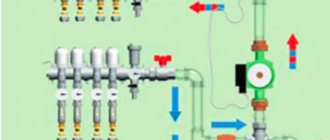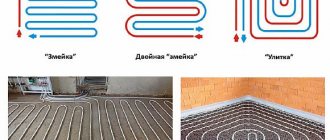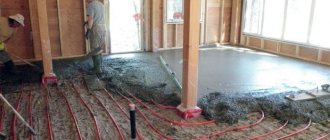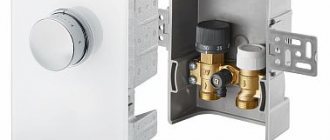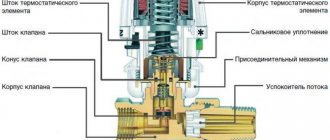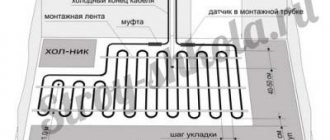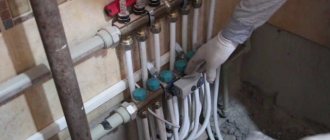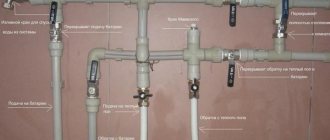Purpose of mixing units
First of all, it should be noted that a mixing unit is used for water heated floors, since the same coolant flows in both the floor heating system and the radiators.
The heating system usually consists of:
- heating boiler in which water is heated;
- one circuit with high-temperature batteries;
- several circuits included in the design of the heated floor.
The boiler included in the system heats the coolant to the temperature required for the operation of the radiators, usually 95 °C, but in some cases 85 and even 75 °C. In accordance with sanitary standards, the temperature on the floor surface cannot be more than 31°C. The restriction is due to many reasons, including comfortable movement around the house.
Taking into account the height of the screed into which the heating system pipelines are embedded, as well as the type and parameters of the floor material, the temperature of the working medium in the pipes should be no more than 55 degrees. It is clear from this that hot water directly from the boiler should not be sent into the heating circuit, since it has too high a temperature.
Therefore, in order to reduce the degree of heating of the working environment at the entrance to the circuit, a mixing unit for a heated floor is installed. It mixes coolant flows with different temperatures. As a result, its temperature decreases and water is supplied to the heating circuit.
Often, property owners are interested in whether a heated floor always requires a mixing unit, and when it can be omitted. Experts say this is quite possible. If the arrangement of heat supply in the house involves the use of low-temperature circuits, and the unit heats the water only to the required temperature for the heating system, then there is no need to install mixing units.
An example is the use of an air heat pump. If the heating boiler supplies water not only to the heated floor structure, but also for taking a shower at a temperature of 65 - 75 ° C, then the heated floor cannot be used without a mixing unit.
Equipment characteristics
The coolant from the boiler passes through the pipe line to the collector. From it the liquid flows into the floor pipeline. Giving up heat, it returns back to the collector, which has a separate return outlet for the cooled coolant. The circulation pump forces water back into the boiler.
When manually controlling the temperature regime, valves are installed on the circuit with cold water and high-temperature coolant. If the room has warmed up well enough, then the hot water valve is closed. If the room is cold, the valve is opened.
To automatically regulate the heating mode, install a three-way mixer with a thermostat and an external temperature sensor. This system forms a thermostatic valve. It is installed at the entrance to the collector. The equipment is made of brass or bronze.
- The three-way valve has 3 outlets for hot, cold water and coolant, which is supplied to the floor line. Markers on the body indicate the direction of flows of different temperatures.
- A mixing chamber is provided to mix liquids of different temperatures.
- On the body there is a thermostat with a temperature regulator.
- The temperature sensor is located on the thermostat.
- The valves close the outlets for cold and hot flow. They can be disc-shaped or needle-shaped. Their operation depends on the thermostat.
- The thermostat is a system that consists of a capsule with liquid and a spring-loaded rod. Valves are attached to it.
- The temperature sensor has a digital panel on which the heating modes are indicated.
We recommend: How to install Grand Meyer underfloor heating?
The thermostat can be located in the thermal head or in the servo drive. The devices have different circuits, but the same principle of operation. The thermal head is a thermostat, the operation of which is carried out using a liquid: it is sensitive to temperature changes.
Servo drives operate from the electrical network. The liquid is contained in a container. It contains a heating plate. The servo drive is installed on the manifold.
The three-way mixer is designed for heating systems of large areas. In separate rooms or in country houses, a two-way valve is connected to the collector. It is installed on a circuit with a high temperature coolant. Water flows through it in only one direction.
Features of the operation of mixing units
The node operates like this:
- The hot coolant reaches the floor heating manifold and reaches the safety valve with thermostat.
- When the heating of the working medium exceeds the required level, the valve is activated and the supply of cold water from the return line begins, as a result of which it is mixed with the hot coolant.
- After the temperature reaches the desired value, the valve is activated again and the flow of hot water stops.
The collector unit is responsible for regulating the degree of heating of the coolant and its circulation in the circuit, and consists of two main elements:
- A safety valve that supplies the heating circuit with hot water as much as required, monitoring the inlet.
- A circulation pump that ensures the coolant moves along the circuit at a certain speed, as a result of which the floor covering will be evenly heated over the entire area.
In addition to them, the mixing unit for heated floors and radiators may include:
- bypass, which prevents system overload;
- air vents;
- shut-off and drain type valves.
Depending on the tasks being solved, the mixing unit of the collector can be equipped in different ways. It is always installed before the contour of the heating structure, but the installation location itself is not precisely indicated. For example, the unit can be made in a room where there is a heated floor, or in a boiler room.
When there are several rooms in a building with heated floors, then the mixing units are placed in each of them separately or in a nearby manifold cabinet. The main difference in the operation of these units is the use of different safety valves. These devices come in 2-way and 3-way types.
Which manufacturer should I choose when purchasing a three-way valve?
The modern market offers a large selection of products. You should start from the general parameters of the valves:
- The type of valve itself.
- Purpose of the valve (for example, for a warm base)
Based on their general parameters, you can determine the brand and cost of the product. Esbe brand valves are very popular on the Russian market . This is a Swedish company that has been producing similar equipment for a century. Trust and reliability accompany the brand at all times. Choosing equipment from this company can guarantee flawless and durable operation.
Particular attention should be paid to the equipment of the American company Honeywell . The products are high-tech, simple and convenient. Installing and using the warm foundation products from this company is a breeze. Innovations are introduced into the technological process of equipment manufacturing every year. Constant updates allow you to achieve maximum efficiency in the operation of products.
Recently, Valtec brand valves have become popular . This company manufactures its products in collaboration with Russian and Italian specialists. The products are of high quality and reasonable prices. The consumer is always provided with accompanying certificates. The warranty period for the products is seven years. The company’s equipment will not fail and will serve for many years.
Installation of three-way valves requires special attention. There are many nuances to consider. Proper installation of equipment will have a positive effect on the performance of the entire heating system.
The best posts
- Polymer floors: do-it-yourself self-leveling coatings, screed technology, pouring PUR floors, how to make liquid polymer
- Classic kitchens
- Knitted bag and crocheted beach panama hat
- Is it possible to lay tiles on gypsum plaster: glue with Rotband, laying on gypsum instead of tile adhesive
- French raglan knitting: jumper pattern with video
- What do forged curtain rods look like in the interior?
- One-room apartment: do-it-yourself renovation
- How to make a form for weaving a basket from newspapers
Mixing unit with two-way valve for heated floors
The 2-way type of device is also called the feeding type. It has a thermostatic head equipped with a liquid sensor that constantly monitors the degree of heating of the working medium, which is supplied to the floor circuit. The head serves to open/close the valve, as a result of which the supply of hot water from the heating boiler is added or cut off.
Mixing of flows is carried out as follows: water from the return flows constantly, and the heated coolant is supplied if necessary, due to the fact that the valve regulates this process. As a result, the floor heating system never overheats and thereby increases its service life.
The two-way device has a low throughput, so the temperature of the working medium is adjusted smoothly. When connecting a mixing unit for a heated floor, specialists prefer using this type of valve. True, there is a restriction on its use - the heated area should not exceed 200 “squares”.
Switching on the three-way thermostatic valve
The valve design includes a special thermal head and a separate temperature sensor. These additional elements allow you to regulate the temperature. Thus, a constant temperature in the system is achieved. The pump moves the liquid in the pipes, and the three-way valve mixes a certain amount of hot flow into the comb.
A three-way mixer is installed at the return outlet. It is worth noting that this classic valve activation scheme may include an additional circulation pump. Otherwise, heating of the heated floor will be insufficient. This circuit does not work well without a pump.
Related article: Design and options for curtains for a kitchen with a balcony: answers to all questions
Mixing unit with three-way valve
The three-way version combines two functions: a bypass balancing valve and a bypass supply valve. Inside it, the flows of cold return and hot coolant are mixed.
Three-way devices are often equipped with servos designed to control thermostatic devices and weather controllers. In this case, there is a damper inside the valve located in the 90 ° zone between the return pipeline and the heated coolant supply pipe from the unit. It can be installed in any location - with a slope to one side or in the middle, depending on the required ratio between hot water and return.
It is generally accepted that this type of valve is indispensable for heating systems with a large number of circuits.
Among the disadvantages of these elements, the following should be noted:
- Cases cannot be excluded when, as a result of a signal from the thermostat, the valve opens and admits coolant having a temperature of 95 ° C into the floor circuit. Such sudden temperature changes during operation of the system are unacceptable, since the pipeline may burst due to excess pressure.
- Three-way valves with significant flow capacity, even in the case of a minimal failure in the adjustment of the device, can greatly change the temperature in the circuit.
To change the power of the floor heating system depending on the weather, special fittings are used - a weather-dependent controller. For example, in the event of a sudden cold snap, the room in the house begins to cool down faster and the heating structure cannot cope with its purpose. To increase its efficiency, the heating of the coolant and its consumption should be increased.
You can use manually controlled valves and turn the valve every time the weather changes. But the disadvantage of this method is obvious: it is difficult to set the optimal mode. That's why many homeowners prefer automatic valves. The controller calculates the required temperature and smoothly controls the device.
The entire 90-degree zone is divided into 20 sectors, each of which has 4.5 degrees. The controller checks the temperature conditions every 20 seconds. When the actual temperature of the water entering the system does not correspond to the calculated one, then the valve turns to one side by 4.5 degrees.
In addition, the controller allows you to save energy. In the absence of residents, it lowers the temperature in the rooms to the lowest possible level.
How does automation work?
A thermostatic three-way valve for underfloor heating is connected in front of the manifold. A certain temperature heating mode is set on the sensor. The device starts working when the parameters are changed.
- The device consists of a semiconductor, which has the temperature of the coolant entering the line. Energy is transferred to the thermostat fluid.
- As the heat increases, the liquid expands and puts pressure on the rod, which lowers.
- In this case, the outlet from the hot pipe is closed and the outlet from the return circuit is opened.
- The cooled coolant enters the three-way mixer chamber, where it is combined with hot water from the boiler. The mixing process can take place according to a T-shaped pattern: hot and cold coolant flow enters the thermostatic mixing valve symmetrically from both sides. The liquid exits into the main line at an angle of 900. With an L-shaped design, hot water enters the mixing chamber from the side.
- The coolant temperature decreases. It enters the floor line cooled. The heating mode strives to reach the set norm.
- As the temperature drops, the liquid in the thermostat contracts. The spring-loaded rod straightens, closing the outlet of cold water that flows through the return pipe. Hot coolant again enters the main line.
When using servo drives, a device that operates from the network is connected to the mixing valve for heated floors. The sensor heats up and closes the electrical circuit. The plate is heated, which in turn transfers heat to the thermal fluid. It expands, pressing on the rod, which makes the poppet valves work.
We recommend: How to install Q-Term heated floors?
When using a servo drive, the heating system changes operating mode within 3 minutes. If you use a thermal head as an automatic device, it will take up to 15 minutes to heat the liquid in the thermostat.
The operating principle of a two-way valve for underfloor heating is somewhat different. When the temperature in the main increases, the thermostat causes poppet valves or a ball device to operate, which completely blocks the outlet for hot water. The cooled coolant from the return pipe returns to the floor circuit.
When the temperature decreases, the valve opens hot water and closes the return flow. There is no mixing of the liquid. The principle of operation of a two-way thermostatic valve for underfloor heating is identical to manual switching of valves, but the system operates in automatic mode.
A three-way thermostatic valve for underfloor heating is installed in a heating system for a large heating area. The equipment is necessary for a boiler that heats water to a high temperature. A two-way valve is connected to the system as additional heating control for individual rooms.
Equipment for automatic control of the heating mode can be installed in a single-circuit or double-circuit heating system. This is convenient when using various types of heating, radiator and floor. The mixer is connected before the circulation pump. I recommend installing a water filter first. When connecting, use the threaded installation method.
Floor mixing unit diagrams
There are many mixing schemes for heated floors. It is possible to arrange the mixing of coolant both upstream of the collector and at all outlets from it.
Each branch must be equipped with such devices as thermostats, flow meters, valves:
- Balancing device for the secondary circuit . Thanks to this valve, the mixing unit of the heated floor is adjusted - the ratio between the volumes of hot and cold coolant from the return is adjusted. To turn the valve, a hex wrench is used, and to prevent displacement, it is secured with a clamping screw. In addition, the device has a flow scale that reflects its throughput, ranging from 0 to 5 cubic meters per hour.
- Balancing shut-off valve for the radiator circuit . This device is intended to connect the mixture group for a heated floor with other elements of the heating system. To turn it, use a hex key.
- Bypass valve . This is a safety device. It protects pumping equipment when operating in a mode where no water is supplied through it. The device is triggered if the pressure in the system drops to a certain value set by the handle.
The mixing unit diagrams for radiators differ, depending on whether a one- or two-pipe heat supply system is being installed. For example, when installing a single-pipe structure, the bypass is always in the open position so that the hot coolant can always partially move towards the batteries. In a two-pipe system, the bypass is closed because it is not needed.
The collector group is not always mounted before the radiator circuit. When the structure has a small area and the drop in temperature of the working environment is insignificant, then the collector with a mixing unit is located on the return of the radiator circuit. In this case, the underfloor heating manifold with a mixing unit works most efficiently.
How to choose equipment?
Thermostatic devices are selected depending on the throughput of the coolant. It must correspond to the volume of liquid that is pumped into the heating system. The data is indicated in the technical data sheet for the boiler.
For the hot and cold circuits, metal pipes with a diameter of 26 * 2 mm are used. The nozzles of a three-way mixer should have the same diameter. Otherwise, you will have to install adapters, which is not desirable for a heating system. The seams bear a high load. It is always necessary to ensure their tightness.
We recommend: How does a flow meter for a heated floor collector work?
The liquid temperature in the floor line is 55-35 0C. The equipment is selected depending on the specific thermal regime that can be set on the thermostat. Radiator heating requires a wider temperature range, up to 80 0C.
To control the temperature in a room with water underfloor heating, thermostatic equipment is used. Automation will facilitate the operation of the heating system, ensure a normal microclimate in individual rooms of the cottage, and save energy.
When using the device with software, it becomes possible to regulate the temperature of the floor line depending on the time of day and days of the week.
YouTube responded with an error: The request cannot be completed because you have exceeded your quota.
- Related Posts
- How to assemble a manifold for a heated floor?
- What kind of warm floor to lay under a parquet board?
- How to lay polystyrene foam for heated floors?
- Is it possible to use underfloor heating as the main heating?
- How does a water heater for underfloor heating work?
- How are pipes for heated floors installed?
Features of automatic devices
To ensure efficient operation of the thermomixing valve, the process of creating a mixed fluid flow must be continuously monitored. It is better if this is done automatically.
Automatically controlled devices are regulated by electrical or pneumatic components.
- Electric drives are relatively inexpensive and easy to connect. This largely explains their popularity and wide distribution. On the other hand, their dependence on power supply and the need for periodic maintenance make them not reliable enough.
- Pneumatic actuators are more expensive, and their connection procedure is more complicated. However, these shortcomings are compensated by a long service life and complete autonomy.
We recommend that you read: Types of plastic taps and their applications


